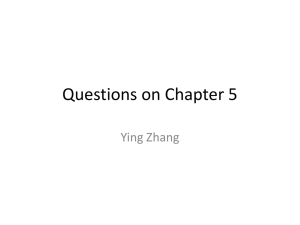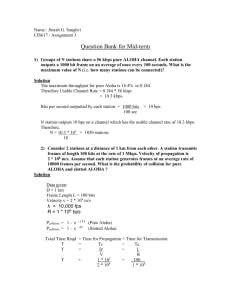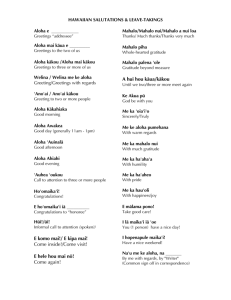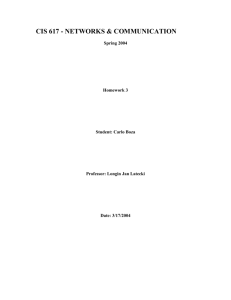Power Laws in ALOHA Systems E6083: lecture 8 Prof. Predrag R. Jelenkovi´c
advertisement
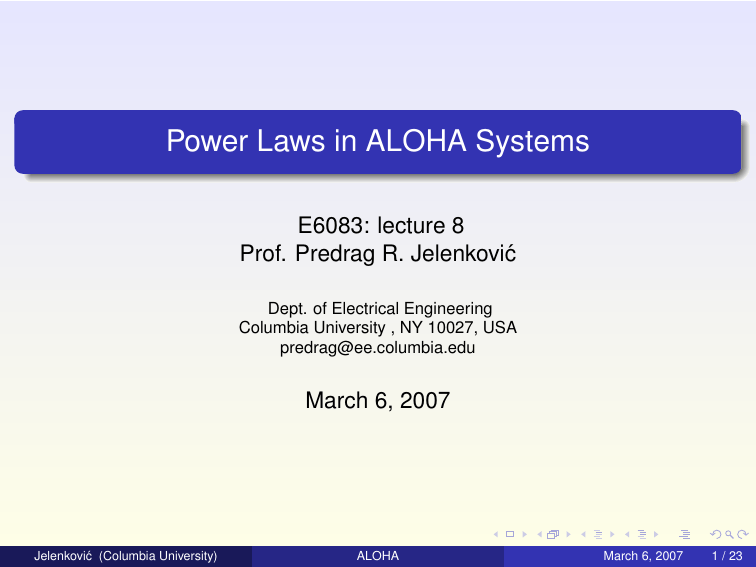
Power Laws in ALOHA Systems
E6083: lecture 8
Prof. Predrag R. Jelenković
Dept. of Electrical Engineering
Columbia University , NY 10027, USA
predrag@ee.columbia.edu
March 6, 2007
Jelenković (Columbia University)
ALOHA
March 6, 2007
1 / 23
Outline
1
ALOHA type of Protocols
2
Power Laws in ALOHA
ALOHA with Variable Size Packets
Power Laws in Slotted ALOHA with Random Number of Users
Jelenković (Columbia University)
ALOHA
March 6, 2007
2 / 23
Renewed Interest in ALOHA
Multiple Access: nodes share a common medium
A receiver can hear several transmitters
A transmitter can broadcast to several
receivers
How to share the medium unaware of the
others?
Hidden terminal
Properties of ALOHA
low complexity
distributed, without coordination
scalable
Jelenković (Columbia University)
ALOHA
March 6, 2007
3 / 23
Classical results (Bertsekas & Gallager, 1992)
Instability of Slotted ALOHA with Infinite Number of Users
If backlog increases beyond
unstable point, then the
departure rate will drop to 0.
Positive throughput with finite number of users
m: total number of users
n: number of backlog
qa : the arrival probability
qr : retransmission probability
with qr > qa
Jelenković (Columbia University)
ALOHA
March 6, 2007
4 / 23
Can power law arise in ALOHA?
Drawback of power law
Compare the sample path of the
power law with the geometric
distribution of the same mean
and variance...
Power law delay may impede the
system periodically, even cause 0
throughput.
Delay in ALOHA with fixed packet length and number of users is
light-tailed.
In reality, both the packet size and the number of users can be
variable.
Jelenković (Columbia University)
ALOHA
March 6, 2007
5 / 23
Outline
1
ALOHA type of Protocols
2
Power Laws in ALOHA
ALOHA with Variable Size Packets
Power Laws in Slotted ALOHA with Random Number of Users
Jelenković (Columbia University)
ALOHA
March 6, 2007
6 / 23
ALOHA with Variable Size Packets
View AlOHA system as a converter
Ta : arrival interval
Tr : transmission time
Polling Questions?
Variable packet sizes can amplify the delay, but how much?
If packet sizes are concentrated (light tailed), is the transmission
delay also light-tailed?
If the number of users is finite and fixed, is the throughput always
positive?
Jelenković (Columbia University)
ALOHA
March 6, 2007
7 / 23
Model Description
Finite number of users M, U(t) is the number of backoffs at time t.
Each user can hold at most one packet in its queue.
New packet is generated after an independent (from all other
variables) exponential time with mean 1/λ.
Each packet has an independent length that is equal in distribution
to a random variable L.
After a collision, each participating user waits (backoffs) for an
independent exponential period of time with mean 1/ν and then
attempts to retransmit its packet.
Jelenković (Columbia University)
ALOHA
March 6, 2007
8 / 23
Visualized Scheme
We study:
N - number of transmission attempts between 2 successful
transmissions.
T - time between 2 successful transmissions.
Jelenković (Columbia University)
ALOHA
March 6, 2007
9 / 23
Power Laws in the Finite Population ALOHA with
Variable Size Packets
Theorem
If
log P[L > x]
= −µ, µ > 0,
x→∞
x
lim
then, we have
lim
n→∞
and
log P[N > n]
Mµ
=−
log n
(M − 1)ν
log P[T > t]
Mµ
=−
.
t→∞
log t
(M − 1)ν
lim
Jelenković (Columbia University)
ALOHA
March 6, 2007
10 / 23
Simulations
Example
4 experiments: M = 2, 4, 10, 20;
packet sizes ∼ i.i.d. exp(1);
arrival intervals and backoffs
∼ exp(2/3);
simulation samples = 105 .
As M gets large (M = 10, 20),
the slopes of the distributions on
the log / log plot are essentially
the same.
Jelenković (Columbia University)
Figure: Interval distribution between
successfully transmitted packets.
ALOHA
March 6, 2007
11 / 23
Implications
the distribution tails of N and T are essentially power laws when
the packet distribution ≈ e−µx .
The finite population ALOHA may exhibit high variations and
possible zero throughput.
0 < Mµ/(M − 1)ν < 1 ⇒ zero throughput;
1 < Mµ/(M − 1)ν < 2 ⇒ Var [T ] = ∞.
For large M, Mµ/(M − 1) ≈ µ/ν and thus, the system has zero
throughput if ν ' µ.
0 throughput may occur even when EL 1/ν.
Jelenković (Columbia University)
ALOHA
March 6, 2007
12 / 23
Nonlinear amplifier
Jelenković (Columbia University)
ALOHA
March 6, 2007
13 / 23
Proof of power laws in ALOHA with variable packet
sizes
1. assuming that a collision happens at time t = 0, i.e., U(0) = M.
2. For x > 0,
P[N > n] = E 1 −
= E 1 −
1
M
M
X
Jelenković (Columbia University)
!!n
e−Li (M−1)ν
1
M
i=1
!!n
e−Li (M−1)ν
1
i=1
+ E 1 −
1
M
M
X
M
\
!
{Li > x }
i=1
M
X
!!n
e−Li (M−1)ν
i=1
1
M
[
!
{Li ≤ x } .
i=1
ALOHA
March 6, 2007
14 / 23
Proof of the first Theorem
3. Upper bound. By using 1 − x ≤ e−x and the independence of Li ,
iM h n −L(M−1)ν
1 −x (M−1)ν n
−M e
+ 1− e
1(L > x )
P[N > n] ≤ E e
M
h n −L1(L>x )(M−1)ν iM
≤ E e− M e
+ ηn .
For any 0 < < µ, there exits x such that P[L > x] ≤ e−(µ−)x for
all x ≥ x , which, by defining random variable L with
d
P[L > x] = e−(µ−)x , x ≥ 0, implies L1(L > x ) ≤ L , therefore,
h n (M−1)ν/(µ−) iM
+ ηn .
P[N > n] ≤ E e− M U
1/α
By using the identity E[e−θU ] = Γ(α + 1)/θα , one can easily
obtain
log P[N > n]
M(µ − )
lim
≤−
.
n→∞
log n
(M − 1)ν
Jelenković (Columbia University)
ALOHA
March 6, 2007
15 / 23
4. Lower bound. Define Lo , min{L1 , L2 , · · · , LM }, and observe that
!!n
M
X
1
P[N > n] = E 1 −
e−Li (M−1)ν
M
i=1
n −Lo (M−1)ν
.
≥E 1−e
For any > 0, there exists x such that P[Lo > x] ≥ e−(Mµ+)x for
all x ≥ x . Define random variable Lo with
d
P[Lo > x] = e−(Mµ+)x , x ≥ 0, then, Lo ≥ Lo 1(Lo > x ), therefore
n
−Lo (M−1)ν
1(Lo > x ) ,
P[N > n] ≥ E 1 − e
which, by using similar techniques in the proof of the upper bound,
implies
log P[N > n]
Mµ + lim
≥−
.
log n
(M − 1)ν
n→∞
Jelenković (Columbia University)
ALOHA
March 6, 2007
16 / 23
5. Passing → 0 in the lower and upper bound, we finish the proof
for the case U(0) = M.
6. Define Ns , min{n ≥ 0 : U(Tn ) = M}, Nl , min{N, Ns } and
Ne , N − Nl . It can be shown that
P[Nl > n] ≤ P[Ns > n] = o(e−θn ), and we obtain
P[Ne > n] = P[N − Ns > n, N > Ns ]
= P[N > Ns ]P[N − Ns > n | N > Ns ]
= P[N > Ns ]P[N > n | Ns = 0],
which yields
lim
n→∞
log P[Nl + Ne > n]
Mµ
log P[N > n]
= lim
=−
.
n→∞
log n
log n
(M − 1)ν
Jelenković (Columbia University)
ALOHA
March 6, 2007
17 / 23
Outline
1
ALOHA type of Protocols
2
Power Laws in ALOHA
ALOHA with Variable Size Packets
Power Laws in Slotted ALOHA with Random Number of Users
Jelenković (Columbia University)
ALOHA
March 6, 2007
18 / 23
Power Laws in Slotted ALOHA with Random Number
of Users
Power laws can be eliminated by reducing the variability of the packet
sizes, however, when the number of active users M is random, we may
also have power laws. Here, backoff ∼ Geo(e−ν ), ν > 0.
Examples
Jelenković (Columbia University)
ALOHA
March 6, 2007
19 / 23
Power Laws in Slotted ALOHA with Random Number
of Users
Theorem
If there exists α > 0, such that, limx→∞
log P[M>x]
x
= −α, then, we have
log P[N > n]
log P[T > t]
α
= lim
=− .
n→∞
t→∞
log n
log t
ν
lim
Theorem (Exact asymptotics)
If λ = ν and F̄ (x) , P[M > x] satisfies H − log F̄ (x) F̄ (x)1/β ∼ xe−νx
with H(x) being continuous and regularly varying, then, as t → ∞,
P[T > t] ∼
Jelenković (Columbia University)
Γ(β + 1)(eν − 1)β
.
t β H(β log t)β
ALOHA
March 6, 2007
20 / 23
Power Laws in Slotted ALOHA with Random Number
of Users
Example (Setting)
If active users M is bounded ⇒ P[T > x] is exponentially bounded.
However, this exponential behavior may happen for very small
probabilities, while the delays of interest can fall inside the region
of the distribution (main body) that behaves as the power law.
Assume that initially M ≥ 1 users have unit size packets ready to
send and M follows geometric distribution with mean 3.
The backoff times of colliding users are independent and
geometrically distributed with mean 2.
M has finite support [1, K ] where K ranges from 6 to 14 and we
set the number of users to be equal to MK = min(M, K ).
Jelenković (Columbia University)
ALOHA
March 6, 2007
21 / 23
Power Laws in Slotted ALOHA with Random Number
of Users
Example (Simulation Results)
The support of the main
body of P[T > t] grows
exponentially fast.
If K = 14, the probabilities
of interest for P[T > t] are
bigger than 1/500, then the
result of this experiment is
basically the same as for
K = ∞.
Jelenković (Columbia University)
Figure: Stretched support of the
power law main body when the
number of users is min(M, K ).
ALOHA
March 6, 2007
22 / 23
Proof of power laws in ALOHA with variable number of
users
1
First consider a situation where all the users are backlogged, i.e.,
have a packet to send.
"
!n #
Me−(M−1)ν (1 − e−ν )
P[N > n] = E
1−
.
1 − e−Mν
On the other hand, we have
t −(M−1)ν
−ν
(1 − e )
P[T > t] = E 1 − Me
, t ∈ N.
2
one can show that the same asymptotic results hold if the initial
number of backlogged users is less than M.
Jelenković (Columbia University)
ALOHA
March 6, 2007
23 / 23

